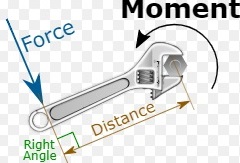Moment
In terms of physics, a moment is the product of a physical quantity and a certain distance, and is usually defined with respect to a fixed reference point. Generally, a moment can be produced by any physical quantity that is multiplied by distance, with commonly-used quantities including force, mass, electric charge, and so on.
The moment of force that acts on an object, known as ‘torque’, is a measure of its tendency to cause the object to rotate about a specific point or axis, and is the product of the force and its distance from the point or axis.
Moment (M) = force (F) x distance (d)
For a moment to develop, the force must act in such a manner that the object begins (or would begin) to twist; in other words, when the force does not have an equal and opposite force directly along the line of action. For example, if two people are stood on opposite sides of a door and both are pushing on it with an equal force then there is equilibrium. If one person stops pushing then there would be no opposing force and the person still pushing would have created a moment of force.
The fixed reference point is also known as the ‘centre of moments’. This can be the actual point about which rotation occurs due to the force, or the axis about which the force may be considered as causing rotation.
A bending moment (BM) is a measure of the bending effect that can occur when an external force is applied to a structural element. This concept is important in structural engineering as it is can be used to calculate where, and how much bending may occur when forces are applied.
For more information see: Bending moment.
[edit] Related articles on Designing Buildings Wiki
Featured articles and news
RTPI leader to become new CIOB Chief Executive Officer
Dr Victoria Hills MRTPI, FICE to take over after Caroline Gumble’s departure.
Social and affordable housing, a long term plan for delivery
The “Delivering a Decade of Renewal for Social and Affordable Housing” strategy sets out future path.
A change to adoptive architecture
Effects of global weather warming on architectural detailing, material choice and human interaction.
The proposed publicly owned and backed subsidiary of Homes England, to facilitate new homes.
How big is the problem and what can we do to mitigate the effects?
Overheating guidance and tools for building designers
A number of cool guides to help with the heat.
The UK's Modern Industrial Strategy: A 10 year plan
Previous consultation criticism, current key elements and general support with some persisting reservations.
Building Safety Regulator reforms
New roles, new staff and a new fast track service pave the way for a single construction regulator.
Architectural Technologist CPDs and Communications
CIAT CPD… and how you can do it!
Cooling centres and cool spaces
Managing extreme heat in cities by directing the public to places for heat stress relief and water sources.
Winter gardens: A brief history and warm variations
Extending the season with glass in different forms and terms.
Restoring Great Yarmouth's Winter Gardens
Transforming one of the least sustainable constructions imaginable.
Construction Skills Mission Board launch sector drive
Newly formed government and industry collaboration set strategy for recruiting an additional 100,000 construction workers a year.
New Architects Code comes into effect in September 2025
ARB Architects Code of Conduct and Practice available with ongoing consultation regarding guidance.
Welsh Skills Body (Medr) launches ambitious plan
The new skills body brings together funding and regulation of tertiary education and research for the devolved nation.
Paul Gandy FCIOB announced as next CIOB President
Former Tilbury Douglas CEO takes helm.
UK Infrastructure: A 10 Year Strategy. In brief with reactions
With the National Infrastructure and Service Transformation Authority (NISTA).























